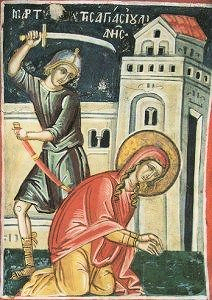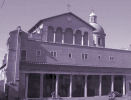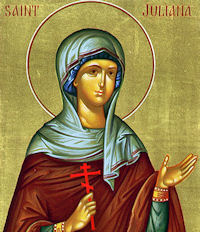Make your gift today!
Help keep Catholics around the world educated and informed.
Already donated? Log in to stop seeing these donation pop-ups.
Ordinary Time: February 16th
Monday of the Sixth Week of Ordinary Time
Other Commemorations: St. Juliana, Virgin and Martyr (RM)
» Enjoy our Liturgical Seasons series of e-books!
"And with a sigh that came straight from the heart he said, 'Why does this generation demand a sign? I tell you solemnly, no sign shall be given to this generation.'" (Mk. 8:12) Faith in the Divinity of Christ Jesus constitutes the first step towards the Divine Life for us as well as for the Jews of His time...God's glory requires that He be served in faith. Let us try and serve Him in faith, just as if we gazed on Him in vision. — Dom Columba Marmion
Meditation on the Gospel - Mark 8:11-13
Jesus expresses the deep sadness he feels at the hard-heartedness of the Pharisees: they remain blind and unbelieving despite the light shining around them and the wonderful things Christ is doing. If someone rejects the miracles which God has offered him, it is useless for him to demand new signs, because he asks for them not because he is sincerely seeking the truth but out of ill will: he is trying to tempt God (cf. Lk 16:27-31). Requiring new miracles before one will believe, not accepting those already performed in the history of salvation, amounts to asking God to account for himself before a human tribunal (cf. Rom 2:1-11). Unfortunately, many people do act like this. But God can only be found if we have an open and humble attitude to him. "I have no need of miracles there are more than enough for me in the Gospel. But I do need to see you fulfilling your duty and responding to grace" (J. Escriva, The Way, 362).
The generation to which Jesus refers does not include all the people of his time, but only the Pharisees and their followers (cf. Mk 8:38; 9:19; Mt 11:16), who do not want to see in Jesus' miracles the sign and guarantee of his messianic mission and dignity: they even attribute his miracles to Satan (Mt 12:28).
If they do not accept the signs offered to them, they will be given no other sign of the spectacular kind they seek, for the Kingdom of God does not come noisily (Lk 17:20-21) and even if it did they in their twisted way would manage to misinterpret the event (Lk 16:31). According to Mt 12:38-42 and Lk 11:29-32, they are offered yet another sign — the miracle of Jonah, the sign of the Death and Resurrection of Jesus Christ; but not even this remarkable proof will lead the Pharisees to shed their pride. — The Navarre Bible - St. Mark
Things to Do:
- Children raised from their infancy with a strong and lively faith will normally not feel the need to resort to petty and skeptical demands that God prove His existence or veracity. What are you doing this week in particular — especially today — to form your children in the truths of the Faith? See the activities links for some ideas of simple things that will impact your children greatly.
St. Juliana of Nicodemia
 St. Juliana suffered martyrdom during the Diocletian persecution. Both the Latin and Greek Churches mention a holy martyr Juliana in their lists of saints. The oldest historical notice of her is found in the "Martryologium Hieronymianum" for 16 February, the place of birth being given as Cumae in Campania (In Campania Cumbas, natale Julianae). It is true that the notice is contained only in the one chief manuscript of the above-named martyrology (the Codex Epternacensis), but that this notice is certainly authentic is clear from a letter of St. Gregory the Great, which testifies to the special veneration of St. Juliana in the neighbourhood of Naples. A pious matron named Januaria built a church on one of her estates, for the consecration of which she desired relics (sanctuaria, that is to say, objects which had been brought into contact with the graves) of Sts. Severinus and Juliana. Gregory wrote to Fortunatus, Bishop of Naples, telling him to accede to the wishes of Januaria (Gregorii Magni epist., lib. IX, ep. xxxv, in Migne P.L., LXXXVII, 1015).
St. Juliana suffered martyrdom during the Diocletian persecution. Both the Latin and Greek Churches mention a holy martyr Juliana in their lists of saints. The oldest historical notice of her is found in the "Martryologium Hieronymianum" for 16 February, the place of birth being given as Cumae in Campania (In Campania Cumbas, natale Julianae). It is true that the notice is contained only in the one chief manuscript of the above-named martyrology (the Codex Epternacensis), but that this notice is certainly authentic is clear from a letter of St. Gregory the Great, which testifies to the special veneration of St. Juliana in the neighbourhood of Naples. A pious matron named Januaria built a church on one of her estates, for the consecration of which she desired relics (sanctuaria, that is to say, objects which had been brought into contact with the graves) of Sts. Severinus and Juliana. Gregory wrote to Fortunatus, Bishop of Naples, telling him to accede to the wishes of Januaria (Gregorii Magni epist., lib. IX, ep. xxxv, in Migne P.L., LXXXVII, 1015).
The Acts of St. Juliana used by Bede in his Martyrologium are purely legendary. According to the account given in this legend, St. Juliana lived in Nicomedia and was betrothed to the Senator Eleusius. Her father Africanus was a pagan and hostile to the Christians. In the persecution of Maximianus, Juliana was beheaded after suffering frightful torturers. Soon after a noble lady, named Sephonia, came through Nicomedia and took the saint's body with her to Italy, and had it buried in Campania. Evidently it was this alleged translation that caused the martyred Juliana, honoured in Nicomedia, to be identified with St. Juliana of Cumae, although they are quite distinct persons. The veneration of St. Juliana of Cumae became very widespread, especially in the Netherlands. At the beginning of the thirteenth century her remains were transferred to Naples. The description of this translation by a contemporary writer is still extant. The feast of the saint is celebrated in the Latin Church on 16 February, in the Greek on 21 December. Her Acts describe the conflicts which she is said to have with the devil; she is represented in pictures with a winged devil whom she leads by a chain.
—Excerpted from The Catholic EncyclopediaPatronage: against bodily ills; sick people; against sickness;
Symbols and Representation: young woman battling a winged devil; young woman being boiled; young woman chaining up a dragon; young woman chaining up and/or scourging the Devil; young woman in a cauldron; young woman leading a chained devil; young woman standing or sitting on a dragon; young woman wearing a crown on her head and a cross on her breast; naked young woman hanging by her hair
Highlights and Things to Do:
- Read more about St. Juliana:
- See the statue of St. Juliana in the Colonnade of St. Peter's Basilica.

Friday after Ash Wednesday
Station with Santi Giovanni e Paolo (Saints John and Paul)
Today's Station on the Coelian Hill was named after two brothers who were officers in the Roman Imperial court. Because they refused to renounce Christ, they were beheaded on June 26, 362. The basilica is where the Christian Senator Pammachius built over their home of the martyrs Sts. John and Paul. Near the church was a hospice where Pammachius dispensed his fortune in charity to the poor.For more on Santi Giovanni e Paolo, see:
For further information on the Station Churches, see The Stational Church.






